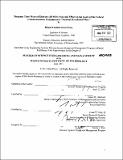| dc.contributor.advisor | James M. Utterback and Frank R. Field, III. | en_US |
| dc.contributor.author | Posey, Brian Wenford Jesse | en_US |
| dc.contributor.other | System Design and Management Program. | en_US |
| dc.date.accessioned | 2012-05-15T21:13:51Z | |
| dc.date.available | 2012-05-15T21:13:51Z | |
| dc.date.copyright | 2011 | en_US |
| dc.date.issued | 2011 | en_US |
| dc.identifier.uri | http://hdl.handle.net/1721.1/70805 | |
| dc.description | Thesis (S.M. in Engineering and Management)--Massachusetts Institute of Technology, Engineering Systems Division, System Design and Management Program, 2011. | en_US |
| dc.description | Cataloged from PDF version of thesis. | en_US |
| dc.description | Includes bibliographical references (p. 99-101). | en_US |
| dc.description.abstract | The Federal Communications Commission (FCC) has stated that broadband is the great infrastructure challenge of the early 21st century. On March 16, 2010 the FCC published "Connecting America: The National Broadband Plan". One of the goals of the FCC Plan is having 1OOM U.S. households with affordable access to actual download speeds of at least 100Mbps and actual upload speeds of at least 50Mbps. The FCC also has the goal that every American should have affordable access to robust broadband (5Mbps) service. This paper examines the potential use of Dynamic Time Metered Delivery (DTMD) in the furtherance of these goals using data and analysis from public sources and TelePulse Technologies Corporation (inventors of DTMD). The key questions the research proposes to answer are: * Using Hypercube analysis, how would key elements of the value chain for phone companies categorize and react to DTMD as an innovation? * Are there specific goals of the FCC National Broadband Plan that might be directly furthered by the use of DTMD? By decreasing the price of broadband performance, DTMD can further FCC goals for broadband adoption in rural communities, less dense suburban communities and low income urban communities. With DTMD and without capital expenditure, the current broadband un-served can be enabled with a broadband speed of minimum 5Mbps on their current phone lines. The cost for a phone company to provide the service goes from being a capital expenditure to a consumable expenditure. In the case of broadband deployment, for rural communities, less dense urban communities and low income urban communities, private sector business goals and public sector goals conflict. Various parts of a broadband provider's value chain may see needed innovation as potentially disruptive, lacking a robust total market, or lacking a high degree of interest by the service provider (the perceived driver of market volume). While private sector investment in broadband has increased, that funding is focused on more at improving current investment with incremental improvement to market proven technologies. FCC driven investment opportunities and incentives to innovate for the unserved should include opportunities to innovate with technologies that are not fully market proven. | en_US |
| dc.description.statementofresponsibility | by Brian Wenford Jesse Posey. | en_US |
| dc.format.extent | 101 p. | en_US |
| dc.language.iso | eng | en_US |
| dc.publisher | Massachusetts Institute of Technology | en_US |
| dc.rights | M.I.T. theses are protected by
copyright. They may be viewed from this source for any purpose, but
reproduction or distribution in any format is prohibited without written
permission. See provided URL for inquiries about permission. | en_US |
| dc.rights.uri | http://dspace.mit.edu/handle/1721.1/7582 | en_US |
| dc.subject | Engineering Systems Division. | en_US |
| dc.subject | System Design and Management Program. | en_US |
| dc.title | Dynamic Time Metered Delivery (DTMD) : potential effect on the goals of the Federal Communications Commission's "National Broadband Plan." | en_US |
| dc.title.alternative | Dynamic Time Metered Delivery : potential effect on the goals of the Federal Communications Commission's "National Broadband Plan." | en_US |
| dc.title.alternative | DTMD : potential effect on the goals of the Federal Communications Commission's "National Broadband Plan." | en_US |
| dc.title.alternative | Potential effect on the goals of the Federal Communications Commission's "National Broadband Plan." | en_US |
| dc.type | Thesis | en_US |
| dc.description.degree | S.M.in Engineering and Management | en_US |
| dc.contributor.department | System Design and Management Program. | en_US |
| dc.contributor.department | Massachusetts Institute of Technology. Engineering Systems Division | |
| dc.identifier.oclc | 792892340 | en_US |
